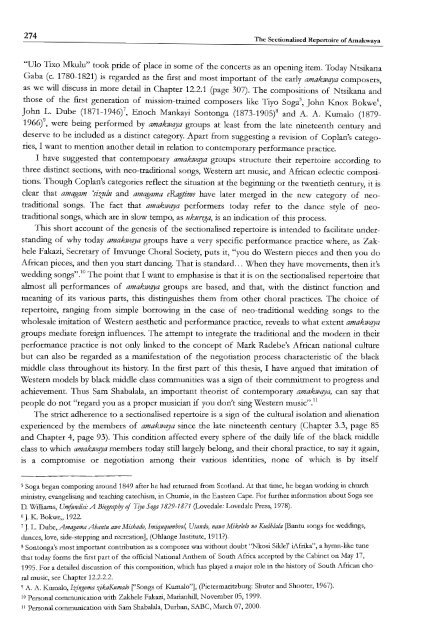South African Choral Music (Amakwaya): Song, Contest and the ...
South African Choral Music (Amakwaya): Song, Contest and the ...
South African Choral Music (Amakwaya): Song, Contest and the ...
Create successful ePaper yourself
Turn your PDF publications into a flip-book with our unique Google optimized e-Paper software.
274 The Sectionalised Repertoire ofAtnakwaya<br />
"Dlo Tixo Mkulu" took pride of place in some of <strong>the</strong> concerts as an opening item. Today Ntsikana<br />
Gaba (c. 1780-1821) is regarded as <strong>the</strong> first <strong>and</strong> most important of <strong>the</strong> early amakwqya composers,<br />
as we will discuss in more detail in Chapter 12.2.1 (page 307). The compositions of N tsikana <strong>and</strong><br />
those of <strong>the</strong> first generation of mission-trained composers like Tiyo Soga S , John Knox Bokwe 6 ,<br />
John L. Dube (1871-1946)7, Enoch Mankayi Sontonga (1873-1905t <strong>and</strong> A. A. Kumalo (1879<br />
1966)9, were being performed by amakwqya groups at least from <strong>the</strong> late nineteenth century <strong>and</strong><br />
deserve to be included as a distinct category. Apart from suggesting a revision of Coplan's categories,<br />
I want to mention ano<strong>the</strong>r detail in relation to contemporary performance practice.<br />
I have suggested that contemporary amakwqya groups structure <strong>the</strong>ir repertoire according to<br />
three distinct sections, with neo-traditional songs, Western art music, <strong>and</strong> <strong>African</strong> eclectic compositions.<br />
Though Coplan's categories reflect <strong>the</strong> situation at <strong>the</strong> beginning or <strong>the</strong> twentieth century, it is<br />
clear that amagam 'Jizulu <strong>and</strong> amagama eRagtime have later merged in <strong>the</strong> new category of neotraditional<br />
songs. The fact that amakwqya performers today refer to <strong>the</strong> dance style of neotraditional<br />
songs, which are in slow tempo, as ukurega, is an indication of this process.<br />
This short account of <strong>the</strong> genesis of <strong>the</strong> sectionalised repertoire is intended to facilitate underst<strong>and</strong>ing<br />
of why today amakwqya groups have a very specific performance practice where, as Zakhele<br />
Fakazi, Secretary of Imvunge <strong>Choral</strong> Society, puts it, "you do Western pieces <strong>and</strong> <strong>the</strong>n you do<br />
<strong>African</strong> pieces, <strong>and</strong> <strong>the</strong>n you start dancing. That is st<strong>and</strong>ard... When <strong>the</strong>y have movements, <strong>the</strong>n it's<br />
wedding songs".lO The point that I want to emphasise is that it is on <strong>the</strong> sectionalised repertoire that<br />
almost all performances of amakwqya groups are based, <strong>and</strong> that, with <strong>the</strong> distinct function <strong>and</strong><br />
meaning of its various parts, this distinguishes <strong>the</strong>m from o<strong>the</strong>r choral practices. The choice of<br />
repertoire, ranging from simple borrowing in <strong>the</strong> case of neo-traditional wedding songs to <strong>the</strong><br />
wholesale imitation of Western aes<strong>the</strong>tic <strong>and</strong> performance practice, reveals to what extent amakwqya<br />
groups mediate foreign influences. The attempt to integrate <strong>the</strong> traditional <strong>and</strong> <strong>the</strong> modern in <strong>the</strong>ir<br />
performance practice is not only linked to <strong>the</strong> concept of Mark Radebe's <strong>African</strong> national culture<br />
but can also be regarded as a manifestation of <strong>the</strong> negotiation process characteristic of <strong>the</strong> black<br />
middle class throughout its history. In <strong>the</strong> first part of this <strong>the</strong>sis, I have argued that imitation of<br />
Western models by black middle class communities was a sign of <strong>the</strong>ir commitment to progress <strong>and</strong><br />
achievement. Thus Sam Shabalala, an important <strong>the</strong>orist of contemporary amakwqya, can say that<br />
people do not "regard you as a proper musician if you don't sing Western music".l1<br />
The strict adherence to a sectionalised repertoire is a sign of <strong>the</strong> cultural isolation <strong>and</strong> alienation<br />
experienced by <strong>the</strong> members of amakwqya since <strong>the</strong> late nineteenth century (Chapter 3.3, page 85<br />
<strong>and</strong> Chapter 4, page 93). This condition affected every sphere of <strong>the</strong> daily life of <strong>the</strong> black middle<br />
class to which amakwqya members today still largely belong, <strong>and</strong> <strong>the</strong>ir choral practice, to say it again,<br />
is a compromise or negotiation among <strong>the</strong>ir various identities, none of which is by itself<br />
5 Soga began composing around 1849 after he had returned from Scotl<strong>and</strong>. At that time, he began working in church<br />
ministry, evangelising <strong>and</strong> teaching catechism, in Chumie, in <strong>the</strong> Eastern Cape. For fur<strong>the</strong>r information about Soga see<br />
D. Williams, Umfundisi: A Biography of Tryo Soga 1829-1871 (Lovedale: Lovedale Press, 1978).<br />
6 J. K. Bokwe" 1922.<br />
7 J. L. Dube, Amagama Abantu awe Mishado, Imiququmbeol, Ut<strong>and</strong>o, nawe Mikelelo no Kudhlala [Bantu songs for weddings,<br />
dances, love, side-stepping <strong>and</strong> recreation], (OWange Institute, 1911 ?).<br />
8 Sontonga's most important contribution as a composer was without doubt "Nkosi Siklel' iAfrika", a hymn-like tune<br />
that today forms <strong>the</strong> first part of <strong>the</strong> official National An<strong>the</strong>m of <strong>South</strong> Africa accepted by <strong>the</strong> Cabinet on May 17,<br />
1995. For a detailed discussion of this composition, which has played a major role in <strong>the</strong> history of <strong>South</strong> <strong>African</strong> cho-<br />
ral music, see Chapter 12.2.2.2.<br />
9 A. A. Kumalo, I:;jngoma :;jkaKumalo ["<strong>Song</strong>s of Kumalo"], (pietermaritzburg: Shuter <strong>and</strong> Shooter, 1967).<br />
10 Personal communication with Zakhele Fakazi, Marianhill, November 05,1999.<br />
11 Personal communication with Sam Shabalala, Durban, SABC, March 07, 2000.

















